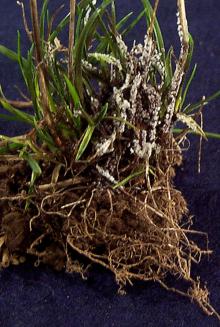Cause Myxomycetes (Physarum spp., Fuligo spp., and Mucilago crustacea) that live in the soil or thatch and are favored by wet weather and an abundance of leaf litter. The appearance of slime mold (sporangia) can cause great concern but is not considered a disease and will recede after 1 to 2 weeks. Sporangia persist in the soil or litter where they have fallen, and they germinate during or after wet conditions. They release motile swarm spores (amoeba-like), which feed on the decaying organic litter as well as on bacteria and other microorganisms. Upon depleting their food source, they change morphologically, forming a plasmodium that grows up from the soil/litter onto the plant. They will grow up virtually any erect surface and when moist, give a "slimy" feel to the plant. The sporangia are then produced, and their presence is the only readily visible portion of their life cycle in the grass seed field. Slime molds can reappear year after year.
Symptoms Leaves will be covered with a grayish or purplish brown, or a white mass of small, round fruiting bodies (sporangia). The plant does not develop any symptoms; the affected leaves don't normally die or turn yellow. The presence of the slime mold interferes with photosynthesis by shading the leaf, but unless the plant is covered heavily, the grass plant usually isn't weakened.
Control No control measures usually needed.


